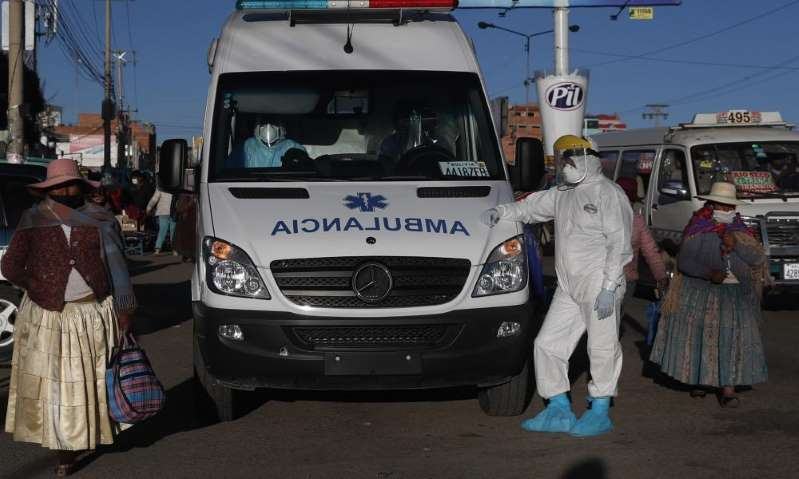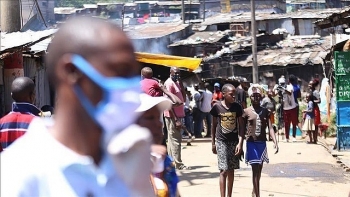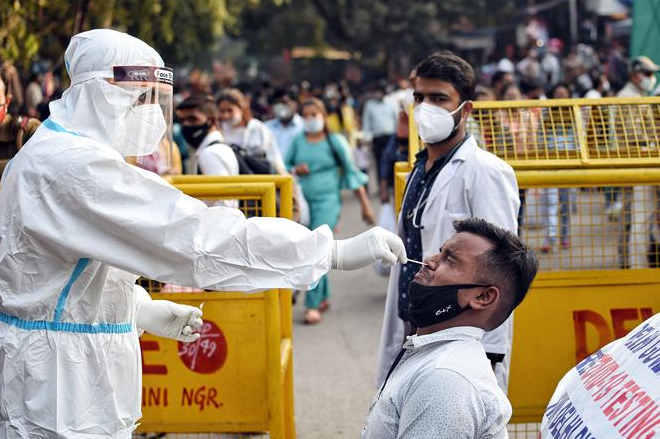Deadly new ebola-like disease found in Bolivia
 |
| A lab worker prepares a glass slide. Boonchai Wedmakawand/Getty Images |
A deadly South American virus that causes Ebola-like bleeding can spread human-to-human, public health officials have learned from its second-ever outbreak.
Public health investigators have reconstructed the path by which the Chapare virus spread from person to person during a 2019 outbreak in Bolivia, leaping from the initial patient to several health care workers.
But while the rodent-borne Chapare virus is highly lethal -- killing three of the five confirmed patients in the latest outbreak -- the pathogen poses very little risk to people in North America, experts said.
"This virus is not one we think is going to really be a major threat to the United States," said Dr. Dan Bausch, president-elect of the American Society of Tropical Medicine and Hygiene. "The virus is important to understand for people who might be traveling in this area of Bolivia, important to understand for people living in that area of the world, and to our greater understanding of these types of viruses, but not something your average person in the U.S. needs to be worried about."
The virus first emerged in 2004, in the Chapare province of Bolivia, about 370 miles east of the country's capital city, La Paz. There was a small cluster of illnesses in that first outbreak, but only a single confirmed case, researchers said in background notes.
The Chapare virus belongs to a different viral family from Ebola, but both can cause hemorrhagic fever in the infected.
In the case of Chapare virus, symptoms can include fever, headache, abdominal pain, rash, and bleeding of the gums, researchers noted. Hemorrhagic fevers ultimately can cause life-threatening organ failure and bleeding.
There is no treatment for Chapare virus, outside of IV fluids and supportive care.
The second outbreak started with a 65-year-old rice farmer who likely caught Chapare virus through contact with rat urine or droppings, said lead researcher Dr. Caitlin Cossaboom, an epidemiologist with the U.S. Centers for Disease Control and Prevention's Division of High Consequence Pathogens and Pathology.
Cossaboom reported on the new outbreak on November 16 at the American Society of Tropical Medicine and Hygiene's annual meeting. Such research is considered preliminary until published in a peer-reviewed journal, according to US News.
 |
| Provided by The Guardian Photograph: Juan Karita/AP |
A 25-year-old doctor caring for the farmer at a hospital in the village of Caranavi was next infected, the investigation revealed.
"The night before he died, she suctioned saliva from his mouth, and then she fell ill nine days later," Cossaboom explained.
A 48-year-old paramedic working in an ambulance that transported the doctor to a La Paz hospital then became the next person in the chain of infection.
"When she was in the ambulance, she needed CPR," Cossaboom said of the doctor. "The ambulance worker that performed CPR on her 16 days later developed symptoms."
When the doctor arrived in La Paz, a gastroenterologist performed an endoscopy on her as part of her treatment -- a procedure in which a small camera is snaked into the mouth to examine a person's upper GI tract.
The gastroenterologist developed symptoms 14 days later, Cossaboom said.
"In all of those cases, we have definitive evidence of exposure to bodily fluids," Cossaboom said.
The initial patient, the village doctor and the gastroenterologist all died from Chapare virus. The ambulance medic and a fifth patient -- a farm worker also from Caranavi -- survived their infection.
Bolivian health officials investigating the outbreak trapped rats in Caranavi, and genetic testing showed that the rats carry the Chapare virus, Cossaboom said.
The species are the pygmy rice rat and the small-eared pygmy rice rat, and they are found across Bolivia and several neighboring countries, researchers said.
Data-sharing help the team very quickly develop a test
 |
| Photo: Gaston Brito/Getty Images |
Using the CDC lab's cutting-edge technology, the international team was able to quickly develop an RT-PCR test to diagnose the virus in the future, according to Insider.
US Centers for Disease Control and Prevention virologist Maria Morales-Betoulle said the speedy response was a team effort among Bolivian scientists and health officials, colleagues at the Pan American Health Organization, and infectious disease experts at CDC headquarters.
"That would have been someone's five-year PhD project when the tools were developing," Bausch said.
"Now these are things that are just done at an incredible pace, and it's really transforming outbreak response in general where we're getting to the point where identifying the pathogen is really no longer the major challenge."/.
 | Australia, New Zealand pledge USD 669 million to ASEAN’s COVID-19 response efforts Australia and New Zealand have pledged over USD 669 million to ASEAN for COVID-19, disease response, economic cooperation and other initiatives, two online ASEAN summits ... |
 | 45-year-old man dies of Covid-19 after three recurrences The man with underlying disease succumbed to the virus after four bouts of infections. The virus in his body has noticeably mutated to more perilous ... |
 | Vietnam donates medical supplies worth $5 million to ASEAN COVID-19 response fund Vietnam dedicated an aid package of medical supplies worth $5 million to the ASEAN Covid-19 response fund, Prime Minister Nguyen Xuan Phuc said at the ... |
Recommended
 World
World
Pakistan NCRC report explores emerging child rights issues
 World
World
"India has right to defend herself against terror," says German Foreign Minister, endorses Op Sindoor
 World
World
‘We stand with India’: Japan, UAE back New Delhi over its global outreach against terror
 World
World
'Action Was Entirely Justifiable': Former US NSA John Bolton Backs India's Right After Pahalgam Attack
 World
World
US, China Conclude Trade Talks with Positive Outcome
 World
World
Nifty, Sensex jumped more than 2% in opening as India-Pakistan tensions ease
 World
World
Easing of US-China Tariffs: Markets React Positively, Experts Remain Cautious
 World
World





